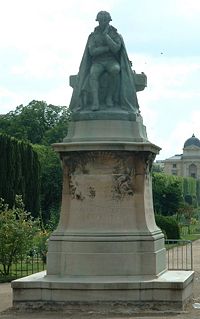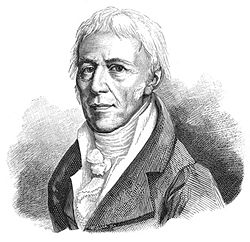Difference between revisions of "Jean-Baptiste Lamarck" - New World Encyclopedia
Katya Swarts (talk | contribs) (added articles and credit tags) |
({{Contracted}}) |
||
| Line 1: | Line 1: | ||
| + | {{Contracted}} | ||
[[Image:Jean-baptiste lamarck2.jpg|right|thumb|Jean-Baptiste Lamarck.|250px]] | [[Image:Jean-baptiste lamarck2.jpg|right|thumb|Jean-Baptiste Lamarck.|250px]] | ||
'''Jean-Baptiste Pierre Antoine de Monet, Chevalier de Lamarck''' ([[August 1]], [[1744]] – [[December 28]], [[1829]]) was a [[France|French]] naturalist and an early proponent of the idea that [[evolution]] occurred and proceeded in accordance with [[Naturalism (philosophy)|natural laws]]. Lamarck is however remembered today mainly in connection with his now superseded theory of [[heredity]], the "[[inheritance of acquired traits]]" (''see [[Lamarckism]]''). He was also one of the first to use the term ''[[biology]]'' in its modern sense.<ref>For a discussion of linguistic priority, see | '''Jean-Baptiste Pierre Antoine de Monet, Chevalier de Lamarck''' ([[August 1]], [[1744]] – [[December 28]], [[1829]]) was a [[France|French]] naturalist and an early proponent of the idea that [[evolution]] occurred and proceeded in accordance with [[Naturalism (philosophy)|natural laws]]. Lamarck is however remembered today mainly in connection with his now superseded theory of [[heredity]], the "[[inheritance of acquired traits]]" (''see [[Lamarckism]]''). He was also one of the first to use the term ''[[biology]]'' in its modern sense.<ref>For a discussion of linguistic priority, see | ||
Revision as of 15:55, 9 April 2007
Jean-Baptiste Pierre Antoine de Monet, Chevalier de Lamarck (August 1, 1744 – December 28, 1829) was a French naturalist and an early proponent of the idea that evolution occurred and proceeded in accordance with natural laws. Lamarck is however remembered today mainly in connection with his now superseded theory of heredity, the "inheritance of acquired traits" (see Lamarckism). He was also one of the first to use the term biology in its modern sense.[1]
Biography
Lamarck was born in Bazentin-le-Petit, Picardie into an impoverished family(hence the title of chevalier - knight).
He served in the army before becoming interested in natural history and writing a multi-volume flora of France. This caught the attention of Georges-Louis Leclerc, Comte de Buffon who arranged for him to be appointed to the Muséum National d'Histoire Naturelle in Paris,France. After years working on plants, Lamarck was appointed curator of invertebrates — another term he coined. He began a series of public lectures. Before 1800, he was an essentialist who believed species were unchanging; however, after working on the molluscs of the Paris Basin, he grew convinced that transmutation or change in the nature of a species occurred over time. He set out to develop an explanation, which he outlined in his 1809 work, Philosophie Zoologique.
Lamarck developed two laws to explain evolution: the law of use and disuse, and the law of inheritance of acquired characteristics.
- (Use and disuse) In every animal which has not passed the limit of its development, a more frequent and continuous use of any organ gradually strengthens, develops and enlarges that organ, and gives it a power proportional to the length of time it has been so used; while the permanent disuse of any organ imperceptibly weakens and deteriorates it, and progressively diminishes its functional capacity, until it finally disappears.
- (Inheritance of acquired characteristics) All the acquisitions or losses wrought by nature on individuals, through the influence of the environment in which their race has long been placed, and hence through the influence of the predominant use or permanent disuse of any organ; all these are preserved by reproduction to the new individuals which arise, provided that the acquired modifications are common to both sexes, or at least to the individuals which produce the young.
Lamarck saw spontaneous generation as being ongoing, with the simple organisms thus created being transmuted over time (by his mechanism) becoming more complex and closer to some notional idea of perfection. He thus believed in a teleological (goal-oriented) process where organisms became more perfect as they evolved. During his lifetime he became controversial; his criticism of the palaeontologist Georges Cuvier’s anti-evolutionary stance won him no friends.
Lamarck married three, possibly four, times. His first marriage was to his mistress from 1777, Marie Delaporte, the mother of his first six children, whom he married on her deathbed in 1792. He remarried in 1795 to Charlotte, but she died in 1797. Lamarck married his third wife, Julie Mallet, in 1798. She died in 1819. Rumours exist of a fourth wife and widow but no documentary evidence exists of her.
Lamarck died penniless in Paris on December 28th, 1829.
Legacy

His defenders believe he is unfairly vilified today. They note that he believed in organic evolution at a time when there was no theoretical framework to explain evolution. He also argued that function precedes form, an issue of some contention among evolutionary theorists at the time. On the other hand, the inheritance of acquired characteristics (also called the theory of adaptation) is now widely rejected. August Weismann claimed to disprove the theory by cutting the tails off mice, demonstrating that the injury was not passed on to the offspring. Jews and other religious groups have been circumcising men for hundreds of generations with no noticeable withering of the foreskin among their descendants. However, Lamarck did not count injury or mutilation as a true acquired characteristic, only those which were initiated by the animal's own needs were deemed to be passed on.
The idea of passing on to offspring characteristics that were acquired during an organism's lifetime is called Lamarckian. This view is inconsistent with modern genetics. Epigenetic inheritance is thought to be Lamarckian, by some, but this is not widely accepted by evolutionary biologists. Epigenetics itself is the study of various gene functions arising from the same gene in different environments. The same gene is passed on to offspring, and the environment determines its expression, so this process still fails to be Lamarckian.
The memetic theory of cultural evolution could be considered a form of Lamarckian inheritance of non-genetic traits. However, this is a point against memetics as a true parallel to genetics, not a point for Lamarckian inheritance.
Charles Darwin not only praised Lamarck in the third edition of The Origin of Species for supporting the concept of evolution and bringing it to the attention of others, but also accepted the idea of use and disuse, and developed his theory of pangenesis partially to explain its apparent occurrence. Darwin and many contemporaries also believed in the inheritance of acquired characteristics, an idea that was much more plausible before the discovery of the cellular mechanisms for genetic transmission.
The pejorative use of the term "Lamarckian" refers specifically to Lamarck's errors regarding the inheritance of acquired characteristics. Many people not properly educated in evolution assume evolution works in a Lamarckian manner, as well as fail to understand that "selection" does not refer to any conscious selecting process by a deity or the individual itself. To understand the way most modern biologists conceive the evolutionary process, it is important that people realize that "trait X was beneficial, so the population got trait X" is shorthand for "trait X was beneficial, individuals without trait X were less likely to propagate, resulting in the population having mostly individuals with trait X."
In botany, his auctorial abbreviation is Lam.
Major Works
On invertebrate classification:
- 1801. Systeme des animaux sans vertebres...[ou tableau genera des classes, des erdres et des genres de ces animaux; presentant leurs caracteres essentiels et leur distribution, d'apres la consideration de leurs.... Paris, Detreville, VIII : 1-432
- 1815-1822 Histoire naturelle des animaux sans vertebres, ... Tome 1 (1815): 1-462; Tome 2 (1816): 1-568; Tome 3 (1816): 1-586; Tome 4 (1817): 1-603; Tome 5 (1818): 1-612; Tome 6, Pt.1 (1819): 1-343; Tome 6, Pt.2 (1822): 1-252; Tome 7 (1822): 1-711.
Trivia
The honeybee subspecies Apis mellifera lamarckii is named after Jean-Baptiste Lamarck.
Footnotes
- ↑ For a discussion of linguistic priority, see the history of the word Biology
See also
- Lamarckism
- Acclimation
- Exaptation
- Evolution
- Gene-centered view of evolution
- Intragenomic conflict
- Lysenkoism
- Maladaptation
- Neutral theory of molecular evolution
- Phenotypic plasticity
- Preadaptation
- Spandrel
External links
- [1] Michael T. Ghiselin recounts Lamarck's times and writings.
- Epigenetics: Genome, Meet Your Environment
- Science Revolution Followers of Lamark
- Lamarck, the Founder of Evolution, His Life and Work, available for free via Project Gutenberg
| Basic topics in evolutionary biology | (edit) |
|---|---|
| Processes of evolution: evidence - macroevolution - microevolution - speciation | |
| Mechanisms: natural selection - genetic drift - gene flow - mutation - phenotypic plasticity | |
| Modes: anagenesis - catagenesis - cladogenesis | |
| History: History of evolutionary thought - Charles Darwin - The Origin of Species - modern evolutionary synthesis | |
| Subfields: population genetics - ecological genetics - human evolution - molecular evolution - phylogenetics - systematics |
| Persondata | |
|---|---|
| NAME | Lamarck, Jean-Baptiste |
| ALTERNATIVE NAMES | de Monet, Jean-Baptiste Pierre Antoine, Chevalier de Lamarck |
| SHORT DESCRIPTION | French naturalist |
| DATE OF BIRTH | August 1, 1744 |
| PLACE OF BIRTH | Bazentin-le-Petit, Picardy, France |
| DATE OF DEATH | December 28, 1829 |
| PLACE OF DEATH | Paris, France |
Credits
New World Encyclopedia writers and editors rewrote and completed the Wikipedia article in accordance with New World Encyclopedia standards. This article abides by terms of the Creative Commons CC-by-sa 3.0 License (CC-by-sa), which may be used and disseminated with proper attribution. Credit is due under the terms of this license that can reference both the New World Encyclopedia contributors and the selfless volunteer contributors of the Wikimedia Foundation. To cite this article click here for a list of acceptable citing formats.The history of earlier contributions by wikipedians is accessible to researchers here:
The history of this article since it was imported to New World Encyclopedia:
Note: Some restrictions may apply to use of individual images which are separately licensed.

